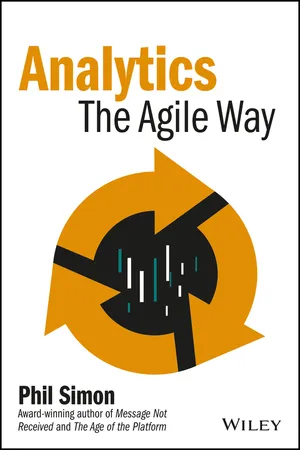
- English
- ePUB (mobile friendly)
- Available on iOS & Android
About This Book
For years, organizations have struggled to make sense out of their data. IT projects designed to provide employees with dashboards, KPIs, and business-intelligence tools often take a year or more to reach the finish line...if they get there at all.
This has always been a problem. Today, though, it's downright unacceptable. The world changes faster than ever. Speed has never been more important. By adhering to antiquated methods, firms lose the ability to see nascent trends—and act upon them until it's too late.
But what if the process of turning raw data into meaningful insights didn't have to be so painful, time-consuming, and frustrating?
What if there were a better way to do analytics?
Fortunately, you're in luck...
Analytics: The Agile Way is the eighth book from award-winning author and Arizona State University professor Phil Simon.
Analytics: The Agile Way demonstrates how progressive organizations such as Google, Nextdoor, and others approach analytics in a fundamentally different way. They are applying the same Agile techniques that software developers have employed for years. They have replaced large batches in favor of smaller ones...and their results will astonish you.
Through a series of case studies and examples, Analytics: The Agile Way demonstrates the benefits of this new analytics mind-set: superior access to information, quicker insights, and the ability to spot trends far ahead of your competitors.
Frequently asked questions
PART ONE
Background and Trends
- Chapter 1: Signs of the Times: Why Data and Analytics Are Dominating Our World
- Chapter 2: The Fundamentals of Contemporary Data: A Primer on What It Is, Why It Matters, and How to Get It
- Chapter 3: The Fundamentals of Analytics: Peeling Back the Onion
CHAPTER 1
Signs of the Times
Why Data and Analytics Are Dominating Our World
Technology is eating the world.—Marc Andreessen, August 20, 2011
THE MONEYBALL EFFECT
Table of contents
- Cover
- Praise for Analytics: The Agile Way
- Wiley & SAS Business Series
- Other Books by Phil Simon
- Title Page
- Copyright
- Epigraph
- Preface: The Power of Dynamic Data
- Introduction It Didn’t Used to Be This Way
- Part One Background and Trends
- Part Two Agile Methods and Analytics
- Part Three Analytics in Action
- Part Four Making the Most Out of Agile Analytics
- Part Five Conclusions and Next Steps
- Afterword
- Acknowledgments
- Selected Bibliography
- About the Author
- Index
- EULA